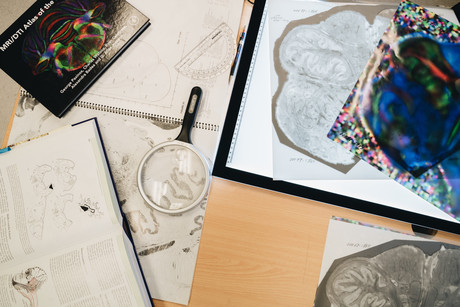Neuroscientist finds hidden region of the human brain

Scientia Professor George Paxinos AO has just discovered a hidden region of the human brain, located near the brain–spinal cord junction and now dubbed the Endorestiform Nucleus.
A world-renowned brain cartographer currently based at Neuroscience Research Australia (NeuRA), Prof Paxinos first suspected the existence of the Endorestiform Nucleus 30 years ago but has only now been able to see it with better staining and imaging techniques. He properly noticed it when he introduced the use of chemical stains, combined with imaging techniques, in the production of his latest atlas.
“There is nothing more pleasant for a neuroscientist than identifying a hitherto unknown area of the human brain,” he said of the find.
The discovery of new brain regions helps researchers to explore cures for diseases including Alzheimer’s, Parkinson’s disease and motor neuron disease. The Endorestiform Nucleus is located within the inferior cerebellar peduncle, an area that integrates sensory and motor information to refine our posture, balance and fine movements.
“I can only guess as to its function, but given the part of the brain where it has been found, it might be involved in fine motor control,” Prof Paxinos said.
Prof Paxinos said the discovery is “like finding a new star”, with the added intrigue that the area in question is absent in monkeys and other animals.
“There have to be some things that are unique about the human brain besides its larger size, and this may be one of them,” he said.
Prof Paxinos is the author of the most cited publication in neuroscience and another 52 books of highly detailed maps of the brain. These maps are uses by brain surgeons and neuroscientists alike as guides for their work, enabling exploration, discovery and the development of treatments for diseases and disorders of the brain.
The discovery of the Endorestiform Nucleus is detailed in his latest book, titled Human Brainstem: Cytoarchitecture, Chemoarchitecture, Myeloarchitecture. It is available for pre-order now.
Dopamine helps our brains to let go of memories
In a discovery that could reshape how we think about memory, researchers at Flinders University...
Vaccine for elephant herpesvirus found to be safe
The vaccine could prevent deadly elephant endotheliotropic herpesvirus in calves — the...
Pig-to-human liver xenotransplant conducted in a living recipient
The case involved a 71-year-old man with hepatitis B-related cirrhosis and hepatocellular...








